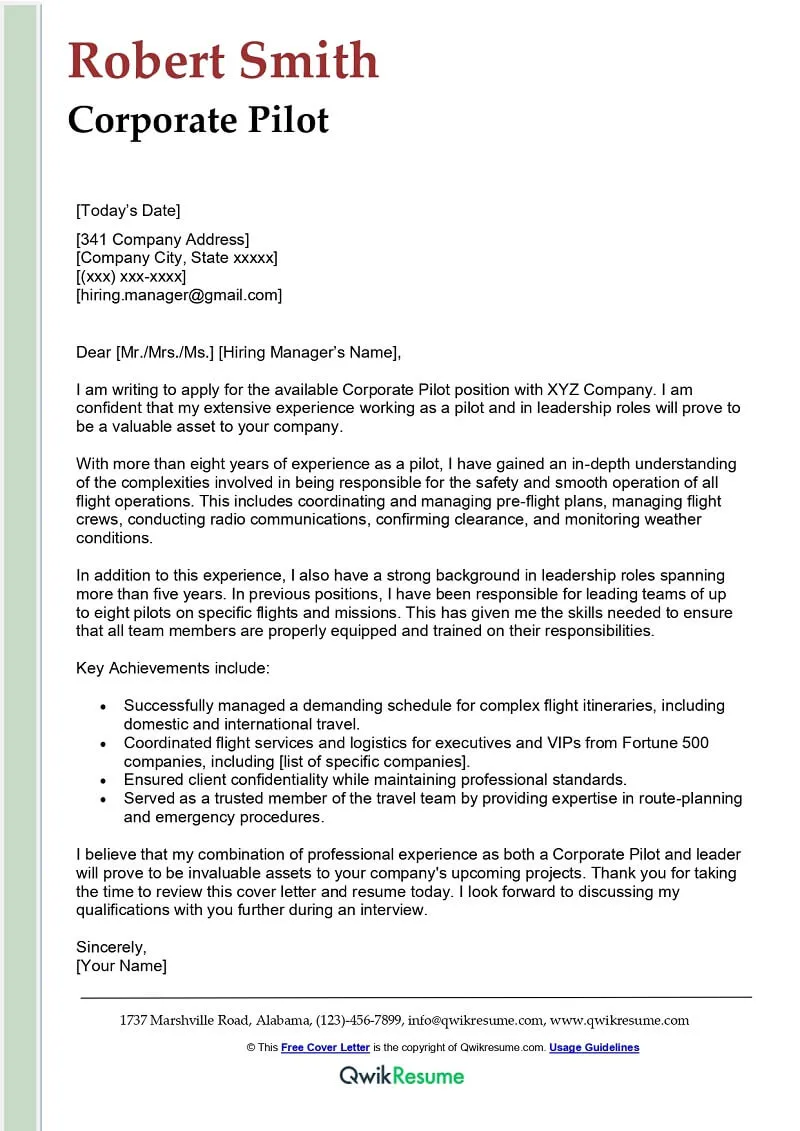Crafting Your Entry Level Pilot Cover Letter
Landing your first pilot position is an exciting prospect, and a well-crafted entry-level pilot cover letter is your first step towards achieving that goal. This document is your opportunity to make a strong first impression, showcasing your personality, skills, and passion for aviation. It’s not just a formality; it’s a crucial part of your application, often the deciding factor in whether or not you get an interview. To make your cover letter stand out, you need to go beyond a simple restatement of your resume. It should be tailored to each specific job, highlighting how your qualifications align with the employer’s needs. Remember, the goal is to convince the hiring manager that you are not only qualified but also the perfect fit for their company culture and the pilot position. Consider using a professional and easy-to-read format, and always tailor your cover letter to the specific job you are applying for.
Highlighting Relevant Skills and Experience
Even if you’re applying for an entry-level pilot position, you likely have skills and experiences that are valuable to potential employers. When writing your cover letter, focus on showcasing those transferable skills. Highlight any flight training you have completed, the number of flight hours logged, and the types of aircraft you are rated to fly. Also, mention any certifications or licenses you possess. Beyond technical skills, emphasize soft skills like problem-solving, decision-making under pressure, teamwork, and communication, as these are essential for a pilot. Any leadership roles you’ve held, volunteer work, or extracurricular activities can further illustrate your character and commitment. Make sure to provide specific examples of how you’ve used these skills to achieve results, quantify your achievements whenever possible and demonstrate that you are a well-rounded individual prepared for the responsibilities of a pilot.
Emphasizing Your Passion for Aviation

Your passion for aviation is what sets you apart. Your cover letter is the ideal place to share your enthusiasm. Don’t be afraid to express your love of flying. Talk about what sparked your interest in aviation, what motivates you to pursue a career as a pilot, and what you find most exciting about the field. Sharing your passion will demonstrate that you are not just looking for a job but are genuinely committed to aviation. This can be conveyed through anecdotes about your early experiences with aviation, the specific types of flying that excite you, or your long-term career aspirations. Showing that you are enthusiastic and dedicated can significantly boost your chances of getting hired, as companies seek pilots who are committed to their profession. Share your genuine interest in aviation; it is a crucial element in an entry-level pilot cover letter.
Demonstrating Knowledge of the Company
Researching the company you’re applying to and demonstrating your knowledge in your cover letter shows your genuine interest and attention to detail. Before writing, learn about the company’s mission, values, and the types of operations they conduct. Show that you understand their business model and what they value in their pilots. Does the company specialize in cargo, passenger flights, or a niche area of aviation? Tailor your letter to reflect this knowledge. You can also mention any recent achievements or initiatives by the company. By showing you’ve done your homework, you signal your eagerness to be part of their team. This can include specific routes they fly, the aircraft they operate, or any notable awards or recognition they’ve received. Mentioning this information will demonstrate that you are not just sending out a generic application, but that you’ve taken the time to learn about their organization. This will help you to stand out from other applicants.
Proofreading and Refining Your Cover Letter
Before you submit your entry-level pilot cover letter, proofreading is an essential step. Errors in grammar, spelling, or punctuation can undermine your credibility and make a negative impression. Read your letter carefully several times, and consider asking a friend, mentor, or career advisor to review it as well. Ensure that the tone is professional and appropriate for the aviation industry. Check for any inconsistencies or inaccuracies in your information. Moreover, ensure your contact information is current and clearly displayed. Pay attention to the layout and formatting to ensure it’s easy to read and visually appealing. A polished, error-free cover letter reflects your attention to detail and your commitment to excellence, both critical qualities for a pilot. A well-presented, carefully proofread cover letter increases your chances of securing an interview and taking the next step in your aviation career.
